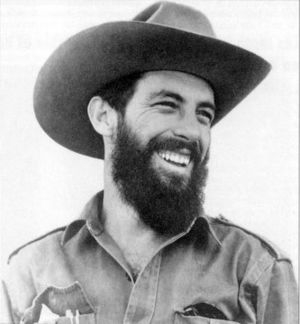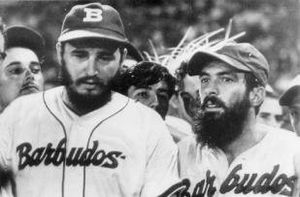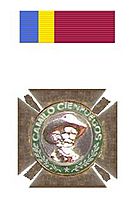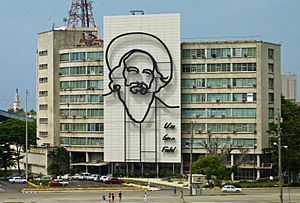Camilo Cienfuegos facts for kids
Quick facts for kids
Camilo Cienfuegos
|
|
|---|---|

Camilo Cienfuegos in Cuba, 1950s
|
|
| Born |
Camilo Cienfuegos Gorriarán
6 February 1932 |
| Disappeared | October 28, 1959 (aged 27) Straits of Florida |
| Status | Missing for 66 years, 1 month and 8 days |
| Nationality | Cuban |
| Organization | 26th of July Movement |
Camilo Cienfuegos Gorriarán (Spanish: [kaˈmilo sjeɱˈfweɣoz ɣorjaˈɾan]; born February 6, 1932 – disappeared October 28, 1959) was a brave Cuban revolutionary from Havana. He was a key member of the 1956 Granma expedition. This journey started Fidel Castro's fight against the Cuban dictator Fulgencio Batista.
Camilo became one of Castro's best guerrilla leaders. He was known as the "Hero of Yaguajay" after winning an important battle during the Cuban Revolution. He often carried a Thompson or a modified M2 carbine.
After Castro's rebel army won in 1959, Camilo was made head of Cuba's armed forces. Later that year, his small plane vanished during a night flight from Camagüey to Havana. He was only 27 years old. Many people have wondered what happened to him. In Cuba, Cienfuegos, whose name means "a hundred fires," is remembered as a hero. There are monuments, memorials, and an annual celebration in his honor.
Contents
Early Life and Beginnings
Camilo Cienfuegos was born on February 6, 1932, in Havana. His family came from Spain before the Spanish Civil War. His father was a tailor who had strong political beliefs.
Camilo was interested in art from a young age. In 1950, he started studying at the Escuela Nacional de Bellas Artes "San Alejandro". However, he had to leave school because his family needed money. He then worked as a tailor's helper.
Around 1948, Camilo became involved in politics. He joined protests against rising bus fares. In 1953, he traveled to the U.S. with a friend to find work. They worked low-paying jobs in cities like New York City and Chicago. Immigration officials eventually sent them back to Cuba. While in New York, Camilo wrote articles for a Cuban political newspaper called La Voz de Cuba.
Joining the Revolution
In 1954, Camilo Cienfuegos actively joined the student movement against President Fulgencio Batista. On December 5, 1955, soldiers shot at Camilo and other students. They were returning from placing a wreath on a monument for Cuban hero Antonio Maceo Grajales. Camilo later said this event made him promise to free Cuba from Batista.
Because he was jobless and harassed by police, he left Cuba in March 1956. He went to the U.S. again, then to Mexico. In Mexico, he planned to join a small rebel army led by Fidel Castro. Camilo became friends with Castro and trained with the rebels. He was one of 82 revolutionaries who sailed to Cuba on the Granma in November 1956.
Camilo was known for his courage and leadership. He was not as focused on political ideas as some others. He believed in fighting for freedom but did not like violence or revenge.
Guerrilla Fighter

The Granma boat arrived in Cuba on December 2. After three days of traveling through swamps, Batista's soldiers attacked the rebels. The surviving rebels escaped in small groups. Camilo was one of only twelve who managed to rejoin Castro a month later in the Sierra Maestra mountains.
In 1957, Camilo became a leader of the revolutionary forces. He was given the rank of Comandante. In 1958, he led one of three groups heading west from the mountains. Their goal was to capture the city of Santa Clara. Che Guevara led another group.
Camilo's and Guevara's groups reached the central provinces. Camilo's group attacked an army base at Yaguajay. After a tough fight, they forced the soldiers to give up on December 30, 1958. This victory earned him the nickname "The Hero of Yaguajay."
Cienfuegos then moved towards Santa Clara with Guevara's forces. Together, they captured Santa Clara on December 31. Most of the soldiers there surrendered easily. Batista fled Cuba the next day, and the rebels won. At a big meeting on January 8, 1959, Castro asked Camilo, "¿Voy bien, Camilo?" ("Am I doing all right, Camilo?"). Camilo's answer, "Vas bien, Fidel" ("You're doing fine, Fidel"), became a famous saying of the revolution.
For several months, Camilo Cienfuegos was the Chief of Staff of the Cuban Army. He helped stop several groups that were against Castro. He also played a role in making changes to how land was used in Cuba.
Mysterious Disappearance
Huber Matos, a military leader in Camagüey province, was worried about communists gaining power in the government. He sent a letter to Fidel Castro resigning from his command. Castro then spoke out against Matos. He sent troops to Camagüey and ordered Camilo Cienfuegos to arrest Matos.
Camilo arrested Matos on October 21. A few days later, on the evening of October 28, 1959, Camilo Cienfuegos' plane disappeared. He was flying from Camagüey back to Havana over the Straits of Florida. A search lasted for several days, but the plane was never found. By mid-November, the search ended, and Camilo was believed to be lost at sea.
Camilo quickly became a hero and a symbol for the Cuban revolution. His disappearance is still a mystery. The Cuban government's historians do not believe there was any foul play. Some people, like Matos, have wondered if Fidel Castro was involved. However, Che Guevara, who was close to Camilo, did not believe Castro was responsible. Others have suggested that a Cuban air force plane might have accidentally shot down Camilo's plane.
Remembering a Hero
Cuba has created a special award called the Order of Cienfuegos in his honor. Every year on October 28, school children across Cuba throw flowers into the sea or a river. This is a way to remember Camilo Cienfuegos. It started as a spontaneous tribute when people heard his plane was lost.
Camilo is also pictured on the 20 Cuban peso bill and the 20 Cuban convertible peso bill. He was also on 40-cent coins, which are no longer used.
The University of Matanzas is named "Camilo Cienfuegos." There are also military high schools for students aged 11 to 17 called the Camilo Cienfuegos Schools. Students who graduate from these schools get special entry into cadet schools. A neighborhood in Havana was also renamed Central Camilo Cienfuegos.
A museum dedicated to Camilo Cienfuegos was built after his death in Yaguajay. It is at the site of the old army barracks from the 1958 battle. The museum shows a model of the battle and items from Camilo's life. A large statue of him stands in front of the museum.
In 2009, on the 50th anniversary of his disappearance, a huge steel outline of Camilo Cienfuegos' face was added to a building in Havana. It also includes the words Vas bien, Fidel.
See also
 In Spanish: Camilo Cienfuegos para niños
In Spanish: Camilo Cienfuegos para niños
- List of people who disappeared mysteriously at sea




